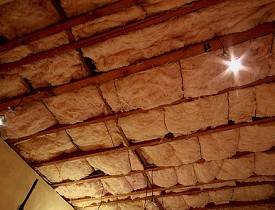What's Wrong With Batt Insulation?
 Fiberglass batts are the commonest insulation materials used in home building, yet the vast majority of the time they are not installed properly, leading to very inefficient construction. This inefficiency is not a problem with the product; rather it lies entirely with the installation. In order for insulating batts to work properly, they have to fit snugly, without any compression or gaps, and be tight against the sheathing or drywall to provide a good air barrier. When any of these don’t happen, the insulation doesn’t perform as it’s supposed to. And most of the time, most of these things don’t happen, and the insulation isn’t doing much good.
Fiberglass batts are the commonest insulation materials used in home building, yet the vast majority of the time they are not installed properly, leading to very inefficient construction. This inefficiency is not a problem with the product; rather it lies entirely with the installation. In order for insulating batts to work properly, they have to fit snugly, without any compression or gaps, and be tight against the sheathing or drywall to provide a good air barrier. When any of these don’t happen, the insulation doesn’t perform as it’s supposed to. And most of the time, most of these things don’t happen, and the insulation isn’t doing much good.
Why it's hard to install batt insulation properly
These problems are not confined to fiberglass. Batts of lambswool, mineral wool, cotton, and any other material are subject to the same installation problems. Now, before we go blaming the people who install the stuff, we need to acknowledge that it is very difficult to install properly. Designed to fit between wall studs, floor joists, and ceiling joists, batts are available in a wide range of thicknesses and widths that fit standard construction spacing dimensions like 16” or 24”.
The problem is once you put in all the windows, doors, interior walls, wiring, plumbing and HVAC, most homes have few, if any, standard size, empty stud cavities for the insulation to fit into. So practically every single batt has to be trimmed to fit the space it goes in, and requires cutting around each receptacle, pipe, and wire. This is very tough work, and since most insulation installers get paid based on how much they install, they blow through their projects quickly, stuffing and jamming insulation anywhere it will fit. Without good quality control, the insulation goes in poorly, it's covered up with drywall, and no one ever thinks about it again, until the homeowners start freezing their buns off in winter because the insulation was installed wrong.
Alternatives to batt insulation
There are alternatives to batt insulation, including blown-in cellulose and fiberglass, spray foam, and foam boards. Though they generally work better than batts, all are subject to installation problems. Are you sensing a theme here? Yes, installation matters a lot. You can take just about any good material and do a bad job installing it. Blow in and spray in products generally do a better job of filling gaps around obstructions and you don’t have to worry about trimming them to fit a special-sized opening. You do still have to make sure they're installed properly without any gaps, and they are in contact with air barriers.
The only insulation that doesn’t require a separate air barrier is spray foam, which is an air barrier itself. But let's get back to batts. Building and energy codes require that insulation be installed according to manufacturer’s instructions, which require tight fits, no compression, and trimming closely around all obstructions. The problem is that the work is almost never done according to these instructions and building departments don’t enforce the code, so most people just go on doing a poor job of installation and homeowners continue to suffer the consequences.
Carl Seville is a green building consultant who works with Altanta HVAC contractors.
Updated July 31, 2018.
Looking for a Pro? Call us (866) 441-6648

Heating & cooling Average Costs
HVAC Contractors Experiences

We Needed A New Bathroom Vent Fan To Get Our House Renter-Ready

Partial Siding Replacement To Get Rid Of Dry Rot



